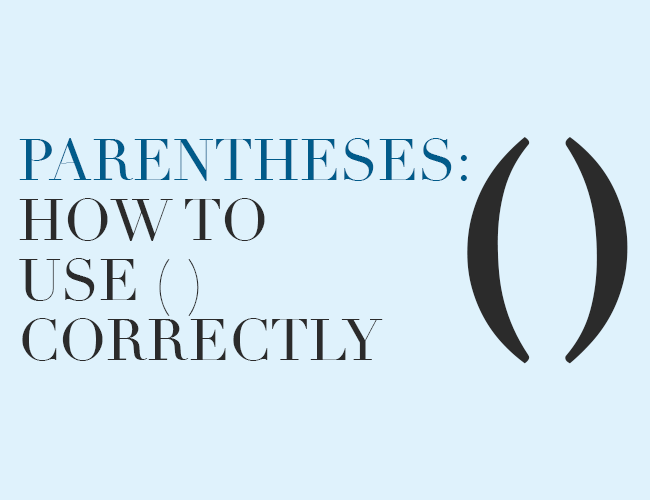‘Parenthesis’ (or the plural ‘parentheses’), also known more informally as ‘brackets’, is the term given to the following punctuation marks: ( ).
There are two rules for using parentheses:
- Parentheses should always be used in pairs.
- Parentheses only enclose non-essential information. That means, the sentence should still make sense if the parenthetical aside were removed.
The etymology of the word ‘parenthesis’ can give us insight into its grammatical purpose. According to the Macquarie Dictionary, the term is a Medieval Latin word, derived from the Greek. It means ‘putting in beside’.
This effectively sums up the role of parentheses; parentheses permit an ‘aside’ or an explanatory interjection within a section of text. Brackets are used in pairs to enclose an explanatory interjection within a sentence. They can also contain whole sentences that function as sidenotes.
You may remember from our earlier article, ‘Use—and Non-use—of Dashes and Hyphens (Part 1 of 2)’, that a pair of em dashes can be used to create an aside in a similar way to parentheses.
You can also watch Dr Lisa Lines’ video on how to use brackets correctly on our YouTube channel.
Using Parentheses to Create an Aside
Parentheses are used to create an aside, an explanatory remark or sidenote. In the following example, taken from The Great Gatsby, F. Scott Fitzgerald has used parentheses so his narrator (Nick) can introduce a rumour about Daisy. This rumour is a relevant sidenote to the plot, but doesn’t progress the sequence of events. For this reason, it has been enclosed within parentheses.
She laughed again, as if she said something very witty, and held my hand for a moment, looking up into my face, promising that there was no one in the world she so much wanted to see. That was a way she had. She hinted in a murmur that the surname of the balancing girl was Baker. (I’ve heard it said that Daisy’s murmur was only to make people lean towards her; an irreverent criticism that made it no less charming.)
Fitzgerald’s use of parentheses provides the reader with insight into the narrator’s perception of the events and characters around him. The intimacy facilitated through the parentheses implicate the reader as Nick’s confidant.
As an aside, Fitzgerald has actually used a semi-colon incorrectly in this paragraph. Please read our article ‘Using Semicolons to Connect Independent Clauses’ to learn why a semicolon should not be used in the parenthetical section of the example above.
Using Parentheses within a Sentence to Create an Aside
Parentheses can also be used within a sentence. For example:
As I never saw my father or my mother, and never saw any likeness of either of them (for their days were long before the days of photographs), my first fancies regarding what they were like, were unreasonably derived from their tombstones.
In this example, taken from Great Expectations, Charles Dickens encloses an aside that clarifies why Pip does not have any knowledge of what his parents looked like.
You will notice the comma is placed outside of the parentheses. This is because the section within the parentheses is a sidenote linked to the dependent clause ‘and never saw any likeness of either of them’. Therefore, the comma goes at the end of the dependent clause, which is considered to be after the sidenote within the brackets.
Additionally, to use parentheses correctly, the sentence must make complete sense if the parentheses and their contents were removed.
Punctuating Parentheses Correctly
When a whole sentence is contained within parentheses, such as shown in the earlier The Great Gatsby example, the full stop (or period) is also enclosed inside the brackets.
In the following example from Jane Eyre, when an aside is placed within a sentence before a full stop, the full stop is placed outside the brackets.
While talking to you, I have occasionally watched Adèle (I have my own reasons for thinking her a curious study—reasons that I may, nay, that I shall impart to you some day).
Again, the sentence should make complete sense if the parenthetical section were removed.
Other Uses for Parentheses
Parentheses are used in author–date referencing styles such as APA and Harvard for in-text citations, which contain author names, dates of publication and page numbers. To learn more about APA in-text referencing, you can read our article ‘APA Referencing—The Finer Points of In-text Referencing’.



